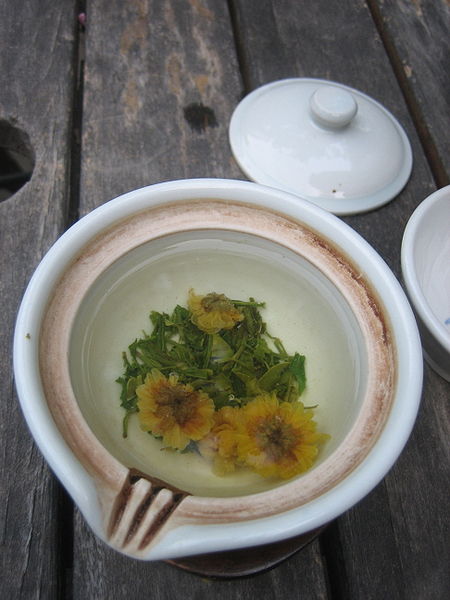Robert Piguet Blossom (2012): Impression of Flowering Tea in the Mouth {Perfume Review & Musings}

Korean Chrysanthemum Tea, "Gukwacha" via Wikipedia
Blossom is part of the new Pacific Collection by Robert Piguet destined primarily, but not exclusively to the Asia-Pacific region and its predominant tastes.
“This is the first time that Piguet has been introduced in Asia—with a line specifically designed for and inspired by Asian Pacific consumers and culture,” said Joe Garces, the brand’s president and CEO to Cosmetic World.
There are of course nuances within that vast region, but generally speaking when it comes to fine perfumery, a sheerer palette is preferred and subtlety is valued.
Blossom seems to take inspiration from the fragrant sensations found in a tea house. The result is however completely different from the type of work signed by Jean-Claude Ellena for Bulgari au Thé Vert, a precursor of tea-based perfumes. You could not either call Blossom a straightforward tea fragrance. It is more suggestive of fragrant steam swirling up from steeped tea leaves than of the brew itself. In other words, it suggests both air and water at the same time. It also is novel in its insistence on recreating a retro-nasal sensation, as if we were indeed smelling inside the mouth. In this composition, perfumer Aurélien Guichard is less frankly sheer than what you would expect in an Ellena opus, his work offering a kind of moiré effect of both sheerness and plushness as if they were interweaved in a transcultural Eastern-Western texture...

Notes: neroli, mandarin/ orange flower absolute / bigaradier leaf, musk.
The perfume evokes the scents of China, more than that of Japan or Korea. Nuances of osmanthus, chrysanthemum, ylang convince you of that. One of its key notes is mandarin in its green, unripe stage (citrus reticulata), a delightful fruit which originates from South-East Asia and reached Europe via the Middle Kingdom at the beginning of the 19th century, hence its English name which refers to Chinese dignitaries. Its essential oil is known for its appeasing qualities. Serge Lutens even dedicated a single opus to the fruit with Mandarine Mandarin.
Aurélien Guichard manages to always brush past those possible references without ever copying them. I detected an influence from My Sin by Lanvin, which is now discontinued, but it is a well-internalized one. One is reminded that he is the author of the famous Chinatown by Bond No.9, a Chinese variation that has been widely applauded for its originality and quirkiness.
Our eau de parfum opens on a very fresh floral bouquet mingling elements of morning dewiness with the warmth of powder and vanilla. As the scent evolves, a green note of something like hyacinth, but which turns out to be green mandarin inflects the composition while the sweetness and the warmth support the floral evolution. The combination is exquisite, with a discreetly delectable quality. While no osmanthus is listed, Blossom recreates a similarly delicate, fruity and fragrant sensation to the full extent of the meaning of the latter word. Its palette is slightly woody, like osmanthus as well.
We seem to be smelling the perfume much more intimately than usual, as if it were warming up on the palate before being swallowed. A touch of salt makes sure we do not miss that subtle gustatory cue. We could be tasting a precious tea infused with rare petals and pausing to let its perfume rise up inside our mouth. The only reminder that we are not deeply inhaling a cup of tea is the note of white musk which here has been showcased with its full characteristics of raspiness and sharpness. However, those have been well tamed and controlled within the composition leaving you with the idea that it is not hiding, but it is not unbalanced either. It requires quite a lot of mastery to achieve that effect. It is like using a material that can be at times cheap and coarse, and making a stylistic statement with it instead of conveying the idea that it is in the perfume for commercial reasons.
The Asian aspect of the perfume can be felt in this perception of a steamy cloud of perfume hovering near teapots and such similar accoutrements of the Chinese rituals of tea. Floral teas are particularly developed a tradition in China. There are blossoming tea bouquets which let escape full flowers in transparent tea pots. We are reminded of this cultural predilection for the silken charm of blooms and their petally sensations in painting, textiles and tea as we wear Blossom. As the perfume blends on skin further, you suddenly are reminded of chrysanthemum tea, with its sweet note. In the air around you, you can feel nuances of jasmine petals floating as if arising from a cup of green tea.
The result is dreamy and highly suggestive of an altogether different atmosphere under different latitudes. You could wear this perfume closer to the epicentre of the inspiration or farther away from it, it will still smell enchanting as well as novel and distinctive thanks to its work on texture and sensation.









